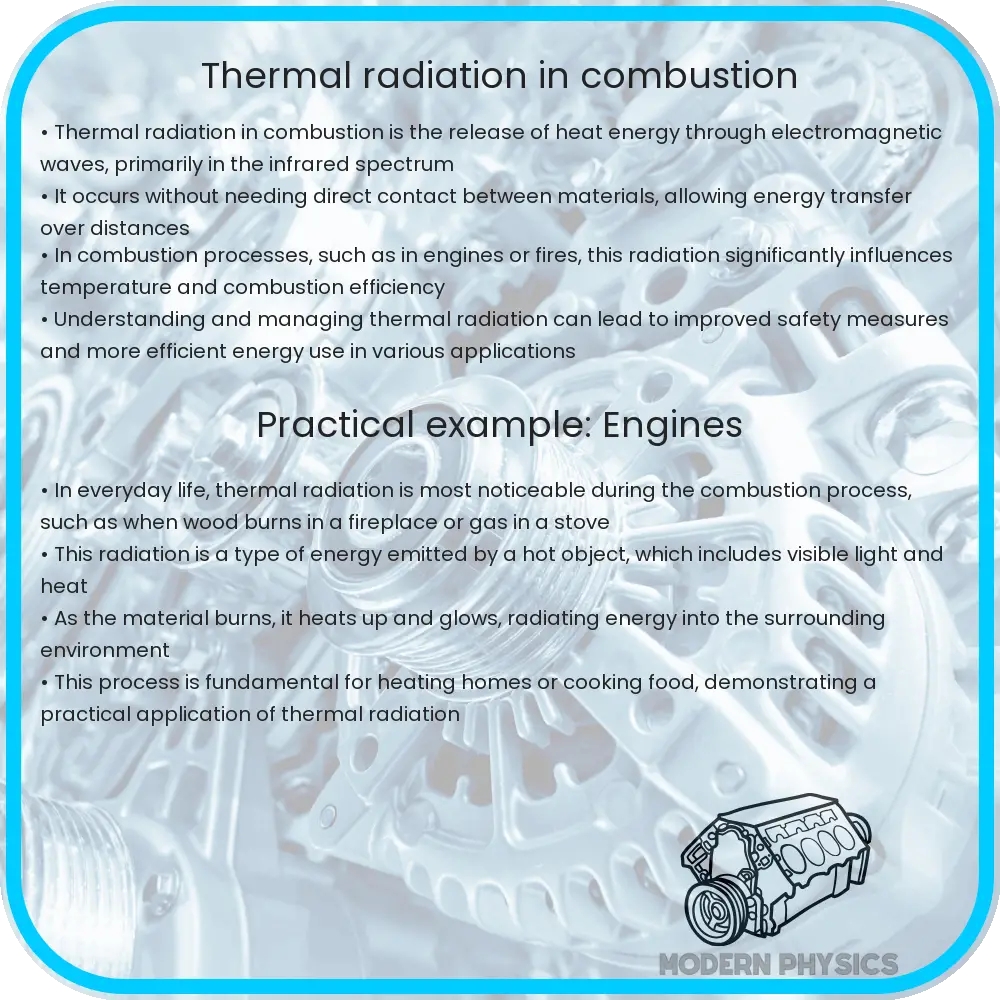Explore the role of thermal radiation in combustion, focusing on heat transfer, efficiency, and environmental impact in modern combustion technologies.

Understanding Thermal Radiation in Combustion
Thermal radiation plays a critical role in combustion processes, influencing both heat transfer and combustion efficiency. This phenomenon refers to the emission of electromagnetic waves from a hot body, which in the context of combustion, typically involves gases and particles at high temperatures.
Heat Transfer in Combustion
Heat transfer in combustion is primarily governed by conduction, convection, and radiation. While conduction and convection involve the transfer of heat through a medium, thermal radiation is unique as it does not require any medium. In combustion systems, thermal radiation is significant due to the high temperatures involved, which can lead to substantial emission of radiant energy. This radiant heat is essential for preheating and igniting fuel, contributing to the overall efficiency of the combustion process.
Efficiency of Combustion
The efficiency of a combustion process is heavily influenced by how effectively it utilizes thermal radiation. Efficient heat transfer ensures optimal fuel ignition and complete combustion, minimizing unburnt fuel and reducing emissions. The temperature, size, and composition of the burning particles and gases determine the spectrum and intensity of the emitted radiation. Higher temperatures typically result in increased radiation and, consequently, improved combustion efficiency.
Control of Thermal Radiation
Controlling thermal radiation in combustion is crucial for optimizing heat transfer and minimizing environmental impact. Techniques like adjusting the combustion temperature, altering the fuel composition, or using radiation shields can effectively manage the radiant heat. Additionally, understanding the absorption and emission characteristics of gases involved in combustion, such as CO2 and H2O, is vital for designing efficient combustion systems.
Chemical Reactions and Thermal Radiation
At the heart of combustion lies a series of chemical reactions, predominantly oxidation, where fuel reacts with an oxidizer (often oxygen in air) to release energy. The chemical formula for a basic hydrocarbon combustion reaction can be represented as:
CxHy + O2 → CO2 + H2O + Heat
This exothermic reaction not only produces heat but also emits thermal radiation, which further propagates the combustion process.
In conclusion, thermal radiation is a fundamental aspect of combustion that impacts heat transfer and efficiency. Its control is essential for designing environmentally friendly and efficient combustion systems. Understanding the interplay between chemical reactions and thermal radiation can lead to significant advancements in combustion technology.
Advanced Applications of Thermal Radiation in Combustion
Modern combustion technologies increasingly focus on harnessing thermal radiation for enhanced performance and sustainability. In industries such as power generation, aerospace, and automotive, advanced combustion systems are being developed to optimize the emission and absorption of thermal radiation. For instance, in gas turbines and internal combustion engines, engineers design combustion chambers that maximize radiant heat transfer to improve efficiency and reduce harmful emissions.
Environmental Impact and Emission Control
The environmental impact of combustion processes cannot be overstated, particularly concerning greenhouse gas emissions and particulate matter. Effective control and management of thermal radiation play a crucial role in reducing these emissions. By optimizing combustion conditions and tailoring the radiation characteristics, it’s possible to achieve cleaner combustion with lower emissions of CO2, NOx, and soot particles.
Future Directions in Combustion Research
Research in thermal radiation and combustion is continually evolving, with a growing emphasis on sustainable and efficient energy use. Future directions include the development of alternative fuels, such as biofuels and hydrogen, that have different combustion characteristics and thermal radiation profiles compared to conventional fossil fuels. Additionally, the integration of advanced computational models and simulation techniques is revolutionizing the way combustion systems are designed and optimized.
Conclusion
Thermal radiation in combustion is a complex yet vital aspect of heat transfer, directly impacting the efficiency and environmental footprint of combustion processes. Its significance extends from fundamental combustion science to practical applications in various industries. As the world moves towards more sustainable energy solutions, understanding and harnessing thermal radiation will be pivotal in developing cleaner, more efficient combustion technologies. Future innovations in this field hold the promise of reducing our reliance on fossil fuels, decreasing greenhouse gas emissions, and paving the way for a more sustainable energy future.
In summary, the study and application of thermal radiation in combustion offer exciting opportunities and challenges. It’s an area where science and technology converge to address some of the most pressing environmental and energy issues of our time.
